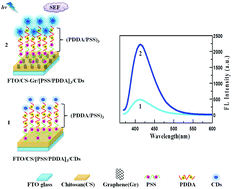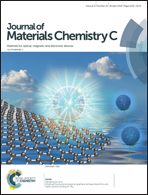Enhanced fluorescence based on graphene self-assembled films and highly sensitive sensing for VB12†
Abstract
In this work, graphene self-assembled multilayers (SAMs) could be successfully employed to construct a surface-enhanced fluorescence (SEF) system. The graphene films (GrFs) were firstly prepared on FTO glass by an electrochemical deposition method. The structures of the SAMs could form when the polyelectrolyte was electrostatically adsorbed, achieving control of the distance between the graphene and the fluorescent carbon dots (CDs) employed as the fluorophore. The enhanced efficiency was found to be strongly dependant on the type and surface morphology of graphene, and the number of polyelectrolyte film layers. A distance dependent increase in fluorescence quantum yield and a decreasing fluorescence lifetime could be observed. The films could achieve a maximum of an ∼5-fold increase in the fluorescence intensity of the CDs when the distance from the graphene surface to the CDs was approximately 3 PDDA/PSS bilayers. It was found that the sensitivity for detecting vitamin B12 (VB12) based on the GrFs was over 50 times that of the fluorophore not attached to the graphene surface. The established graphene-enhanced fluorescence system based on the SAMs shows highly sensitive sensing for VB12.



 Please wait while we load your content...
Please wait while we load your content...